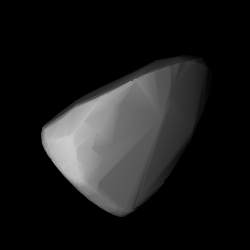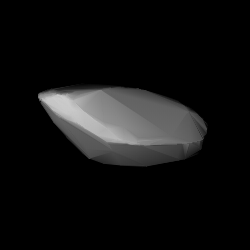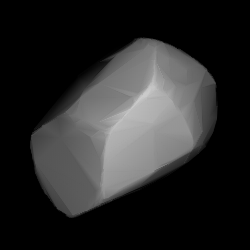Related Research Articles

1050 Meta, provisional designation 1925 RC, is a stony Eunomia asteroid from the central regions of the asteroid belt, approximately 10 kilometers in diameter. It was discovered on 14 September 1925, by German astronomer Karl Reinmuth at the Heidelberg Observatory in southwest Germany. The meaning of the asteroids's name is unknown. The presumably S-type asteroid has a rotation period of 6.14 hours and possibly an elongated shape.

1554 Yugoslavia, provisional designation 1940 RE, is a stony Eunomian asteroid from the middle region of the asteroid belt, approximately 16 kilometres (9.9 mi) in diameter. It was discovered by Serbian astronomer Milorad Protić at Belgrade Astronomical Observatory, Serbia, on 6 September 1940. It was named for the former country of Yugoslavia.
1106 Cydonia, provisional designation 1929 CW, is a Eunomian asteroid from the central regions of the asteroid belt, approximately 13 kilometers in diameter. It was discovered on 5 February 1929, by astronomer Karl Reinmuth at the Heidelberg-Königstuhl State Observatory in Germany. The asteroid was named for the fruit-bearing tree Cydonia (quince). The S-type asteroid has a relatively short rotation period of 2.7 hours.
4149 Harrison, provisional designation 1984 EZ, is a stony Eunomian asteroid from the middle region of the asteroid belt, approximately 10 kilometers in diameter. The asteroid was discovered on 9 March 1984, by American astronomer Brian Skiff at Lowell's Anderson Mesa Station in Flagstaff, Arizona, and named after musician George Harrison.

1677 Tycho Brahe, provisional designation 1940 RO, is a stony Marian asteroid from the central region of the asteroid belt, approximately 12 kilometers in diameter. It was discovered on 6 September 1940, by Finnish astronomer Yrjö Väisälä at Turku Observatory in Southwest Finland. The common stony S-type asteroid has a short rotation period of 3.89 hours. It was later named after Tycho Brahe, one of the fathers of astronomy.
1215 Boyer, provisional designation 1932 BA, is a stony Eunomian asteroid from the central region of the asteroid belt, approximately 20 kilometers in diameter. It was discovered by astronomer Alfred Schmitt in 1932, who named it after French astronomer and college Louis Boyer.

2490 Bussolini is an Eunomia asteroid from the central region of the asteroid belt, approximately 12 kilometers in diameter. It was discovered on 3 January 1976, by staff members of the Félix Aguilar Observatory at El Leoncito Complex in Argentina. The asteroid was named after Argentine Jesuit physicist Juan Bussolini.
1707 Chantal, provisional designation 1932 RL, is a stony background asteroid from the Florian region in the inner asteroid belt, approximately 7.5 kilometers in diameter. It was discovered on 8 September 1932, by astronomer Eugène Delporte at the Royal Observatory of Belgium in Uccle. The S-type asteroid has a rotation period of at least 10 hours. It was named for Chantal, the niece of Belgian astronomer Georges Roland.

1275 Cimbria is a Eunomia asteroid from the central regions of the asteroid belt, approximately 27 kilometers in diameter. It was discovered on 30 November 1932, by astronomer Karl Reinmuth at the Heidelberg-Königstuhl State Observatory in southern Germany. The asteroid was named after the Cimbri, an ancient Germanic tribe.
5256 Farquhar, provisional designation 1988 NN, is a stony Eunomian asteroid from the middle regions of the asteroid belt, approximately 12 kilometers in diameter. It was discovered on 11 July 1988, by American astronomers Eleanor Helin, Celina Mikolajczak and Robert Coker at the Palomar Observatory in California. The asteroid was later named for American NASA specialist Robert W. Farquhar.

2181 Fogelin is an Eunomia asteroid from the central regions of the asteroid belt, approximately 11 kilometers in diameter. It was discovered on 28 December 1942, by Germany astronomer Karl Reinmuth at the Heidelberg Observatory in southwest Germany. In 1980, it was named for Eric S. Fogelin an assistant at the Minor Planet Center. The likely elongated S-type asteroid has a rotation period of 14.07 hours.
3714 Kenrussell, provisional designation 1983 TT1, is a Eunomian asteroid from the central regions of the asteroid belt, approximately 10 kilometers (6 miles) in diameter. It was discovered on 12 October 1983, by American astronomer Edward Bowell at the Anderson Mesa Station near Flagstaff, Arizona, in the United States. It was named for Australian astronomer Kenneth S. Russell. The presumably stony asteroid has a rotation period of 5.25 hours.
1384 Kniertje, provisional designation 1934 RX, is a dark Adeonian asteroid from the central regions of the asteroid belt, approximately 26 kilometers in diameter. It was discovered on 9 September 1934, by Dutch astronomer Hendrik van Gent at the Union Observatory in Johannesburg, South Africa. The asteroid was named after a character in the Dutch play Op Hoop van Zegen by Herman Heijermans.
1238 Predappia, provisional designation 1932 CA, is a dark Adeonian asteroid from the central regions of the asteroid belt, approximately 21 kilometers in diameter. It was discovered on 4 February 1932, by astronomer Luigi Volta at the Observatory of Turin in Pino Torinese, Italy. It was later named after the Italian village of Predappio.
2308 Schilt, provisional designation 1967 JM, is a stony Eunomia asteroid from the asteroid belt, approximately 17 kilometers in diameter. It was discovered on 6 May 1967, by Argentine astronomer Carlos Cesco together with American astronomer Arnold Klemola at the Yale–Columbia Southern Station at Leoncito Astronomical Complex in Argentina.

2384 Schulhof (prov. designation: 1943 EC1) is a mid-sized asteroid and the namesake of the Schulhof family, located in the Eunomian region of the intermediate asteroid belt. It was discovered on 2 March 1943, by French astronomer Marguerite Laugier at Nice Observatory in southeastern France. The asteroid was later named after Hungarian astronomer Lipót Schulhof. The presumed S-type asteroid has a short rotation period of 3.3 hours and measures approximately 12 kilometers (7.5 miles) in diameter.
5692 Shirao, provisional designation 1992 FR, is a stony Eunomia asteroid from the middle region of the asteroid belt, approximately 9 kilometers in diameter. It was discovered on 23 March 1992, by Japanese amateur astronomers Kin Endate and Kazuro Watanabe at Kitami Observatory, Hokkaidō, Japan. The asteroid was later named for Japanese geologist and astrophotographer Motomaro Shirao.

6882 Sormano (prov. designation: 1995 CC1) is an stony Eunomia asteroid from the middle region of the asteroid belt, approximately 7 kilometers (4.3 miles) in diameter. It was discovered on 5 February 1995, by Italian amateur astronomers Piero Sicoli and Valter Giuliani at Sormano Astronomical Observatory in northern Italy. The asteroid was named for the Italian mountain-village of Sormano and its discovering observatory.

1927 Suvanto, provisional designation 1936 FP, is a stony Eunomian asteroid from the central region of the asteroid belt, approximately 12 kilometers in diameter. It was discovered on 18 March 1936, by Finnish astronomer Rafael Suvanto at the Turku Observatory in Southwest Finland. The asteroid was posthumously named in honor of the discoverer.
13390 Bouška, provisional designation 1999 FQ3, is a stony Eunomia asteroid from the central region of the asteroid belt, approximately 7 kilometers in diameter. It was discovered by Czech astronomers Petr Pravec and Marek Wolf at Ondřejov Observatory in the Czech Republic on 18 March 1999. It was named after astronomer Jiří Bouška.
References
- 1 2 3 4 "JPL Small-Body Database Browser: 21558 Alisonliu (1998 QW77)" (2017-02-21 last obs.). Jet Propulsion Laboratory . Retrieved 27 June 2017.
- 1 2 3 Schmadel, Lutz D. (2009). Dictionary of Minor Planet Names – (21558) Alisonliu, Addendum to Fifth Edition: 2006 – 2008. Springer Berlin Heidelberg. p. 86. ISBN 978-3-642-01964-7 . Retrieved 12 May 2016.
- 1 2 3 4 5 6 "LCDB Data for (21558) Alisonliu". Asteroid Lightcurve Database (LCDB). Retrieved 12 May 2016.
- 1 2 3 Masiero, Joseph R.; Grav, T.; Mainzer, A. K.; Nugent, C. R.; Bauer, J. M.; Stevenson, R.; et al. (August 2014). "Main-belt Asteroids with WISE/NEOWISE: Near-infrared Albedos". The Astrophysical Journal. 791 (2): 11. arXiv: 1406.6645 . Bibcode:2014ApJ...791..121M. doi:10.1088/0004-637X/791/2/121. S2CID 119293330 . Retrieved 3 December 2016.
- 1 2 3 4 Mainzer, A.; Grav, T.; Masiero, J.; Hand, E.; Bauer, J.; Tholen, D.; et al. (November 2011). "NEOWISE Studies of Spectrophotometrically Classified Asteroids: Preliminary Results". The Astrophysical Journal. 741 (2): 25. arXiv: 1109.6407 . Bibcode:2011ApJ...741...90M. doi:10.1088/0004-637X/741/2/90. S2CID 118700974 . Retrieved 12 May 2016.
- 1 2 Albers, Kenda; Kragh, Katherine; Monnier, Adam; Pligge, Zachary; Stolze, Kellen; West, Josh; et al. (October 2010). "Asteroid Lightcurve Analysis at the Oakley Southern Sky Observatory: 2009 October thru 2010 April". The Minor Planet Bulletin. 37 (4): 152–158. Bibcode:2010MPBu...37..152A. ISSN 1052-8091 . Retrieved 20 December 2015.
- 1 2 3 Veres, Peter; Jedicke, Robert; Fitzsimmons, Alan; Denneau, Larry; Granvik, Mikael; Bolin, Bryce; et al. (November 2015). "Absolute magnitudes and slope parameters for 250,000 asteroids observed by Pan-STARRS PS1 - Preliminary results". Icarus. 261: 34–47. arXiv: 1506.00762 . Bibcode:2015Icar..261...34V. doi:10.1016/j.icarus.2015.08.007. S2CID 53493339 . Retrieved 12 May 2016.
- 1 2 "21558 Alisonliu (1998 QW77)". Minor Planet Center. Retrieved 12 May 2016.
- ↑ "MPC/MPO/MPS Archive". Minor Planet Center. Retrieved 12 May 2016.